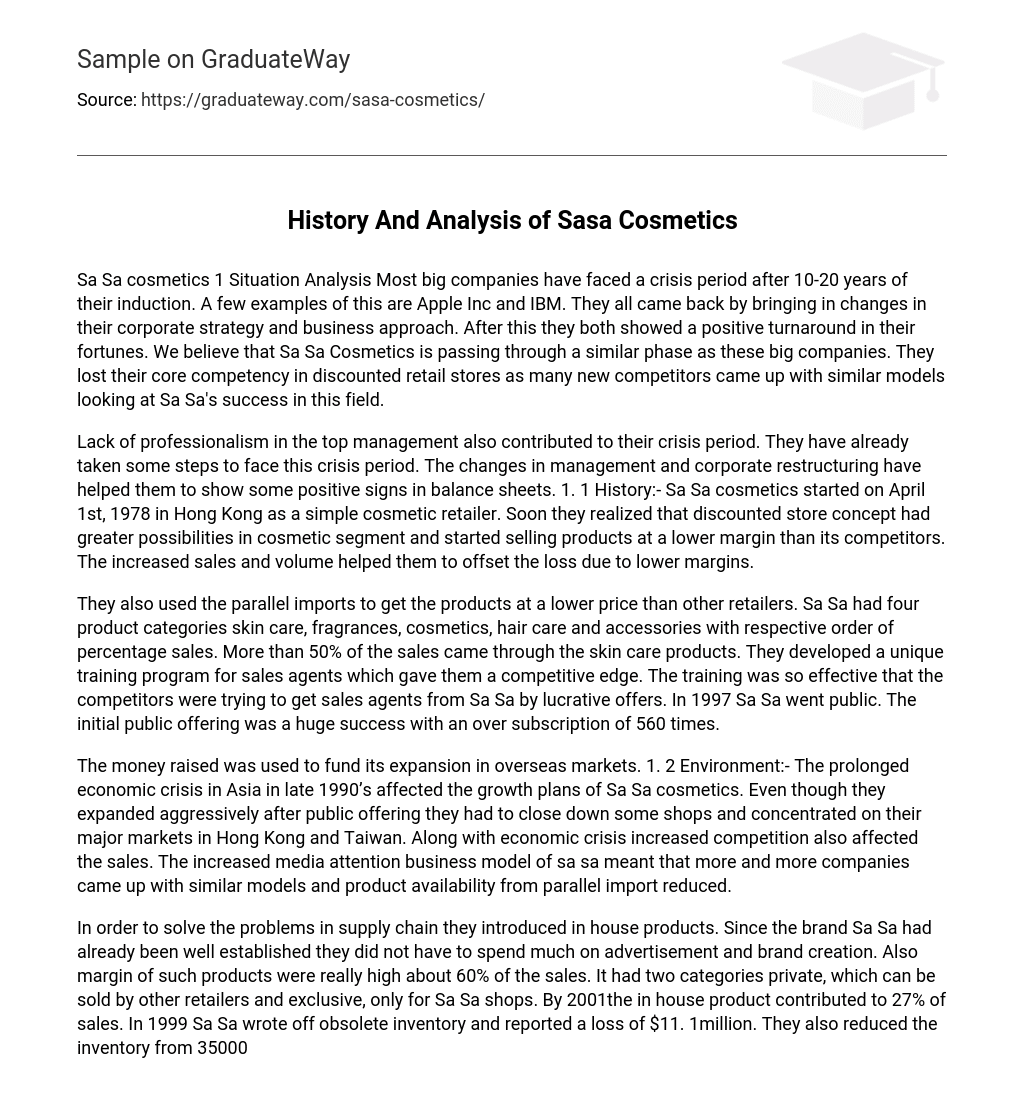Sa Sa cosmetics 1 Situation Analysis Most big companies, like Apple Inc and IBM, have experienced a crisis period after being in business for 10-20 years. However, they managed to turn things around by making adjustments to their corporate strategy and business approach. Similarly, Sa Sa Cosmetics is currently undergoing a similar phase as these companies did. Due to the emergence of new competitors with similar discounted retail store models, Sa Sa lost its core competency in this field, which was once its key to success.
Lack of professionalism in the top management played a role in the crisis period experienced by the company. However, they have taken measures to address this crisis. The restructuring of management and corporate changes have resulted in positive improvements in their financial statements.
1. 1 History:- Sa Sa cosmetics was established on April 1st, 1978 in Hong Kong as a basic cosmetic retailer. They soon recognized the potential of a discounted store concept in the cosmetic industry and began selling products at lower prices compared to their competitors. This strategy, despite lower profit margins, led to increased sales and volume, helping them offset the loss incurred.
By using parallel imports, Sa Sa was able to obtain products at a lower price compared to other retailers. The company offered a variety of product categories including skin care, fragrances, cosmetics, hair care, and accessories, with skin care products accounting for over 50% of sales. Sa Sa also had a unique training program for sales agents, which gave them a competitive advantage. This training program was so effective that competitors tried to attract Sa Sa’s sales agents with lucrative offers. In 1997, Sa Sa went public and its initial public offering was extremely successful, with an oversubscription of 560 times.
The money raised was utilized to support the company’s expansion in international markets. The economic crisis in Asia in the late 1990s had a negative impact on Sa Sa cosmetics’ growth plans. Despite their aggressive expansion after going public, they had to shut down certain stores and focus on their major markets in Hong Kong and Taiwan. In addition to the economic crisis, increased competition also affected sales. The heightened media coverage of Sa Sa’s business model led to the emergence of more companies with similar models, and the availability of products from parallel importation decreased.
Sa Sa addressed supply chain issues by implementing in-house products. Due to the established Sa Sa brand, heavy investments in advertising or brand building were unnecessary. Moreover, these products yielded a high profit margin, representing approximately 60% of sales. The in-house product line consisted of two categories: private label items available for sale through other retailers and exclusive items solely found in Sa Sa stores. By 2001, these in-house products accounted for 27% of total sales. In 1999, obsolete inventory was written off resulting in a loss of $11.1 million. Additionally, inventory was reduced from 35,000 SKU to 22,000 SKU as the majority of sales relied on only 20% of the total inventory.
To revive the company, experienced individuals were brought in at the top management level and the business was restructured. Moving forward, Sa Sa, which had lost its core competency in discounted retail stores, needs to focus on innovation and gaining a competitive advantage over new entrants. They also need to address the cost issues associated with their long inventory period.
The objectives are to reduce the inventory period from 150 days, increase the sales of in-house products, and expand into other Asian markets.
The alternatives include implementing a centralized inventory monitoring system similar to Walmart’s and aggressively marketing their in-house products.
The decision criteria are long-term and short-term profitability, as well as regaining competitive advantage. Sa Sa Cosmetics has lost some of its competitive edge due to new players entering the industry. However, they have the largest market share and risk-bearing capability, which give them opportunities to regain this advantage.
Analysis shows that retail giants like Walmart have centralized inventory monitoring systems to improve efficiency in inventory handling. When a sale occurs in any of Walmart’s retail shops, the details are sent to the computer system at their headquarters.
If the inventory level falls below a critical value, the system automatically orders products from the manufacturer. This efficient monitoring system is one of the reasons behind Walmart’s high efficiency and low prices. Additionally, it will help decrease the inventory period, improving operational efficiency and increasing short-term profits. Overall efficiency will provide a competitive advantage over rivals, resulting in long-term profitability and stability for the company. Sa Sa Cosmetics is also seeking expansion in Asian markets.
Sa Sa Cosmetics requires a system to manage the substantial amount of data generated by individual shops. This system is vital for inventory control and future company expansion plans.
With a 60% margin for their in-house products, Sa Sa Cosmetics also sells well-established brands. To boost the market share of their own brands, they must aggressively market their in-house products. While this may initially affect profitability, it will ultimately lead to higher sales, profit margin, and brand value in the market.
The increase in sales of their in-house products will decrease reliance on private labelled brands, leading to a reduction in the inventory period. There are 6 recommendations:
- Introduction of a centralised inventory system to manage inventory efficiently and increase operational profits.
- Currently, only 1% of their sales is allocated to promotional activities, which is significantly lower than industry standards. Therefore, they should increase their advertisement expenditure to approximately 5%.





